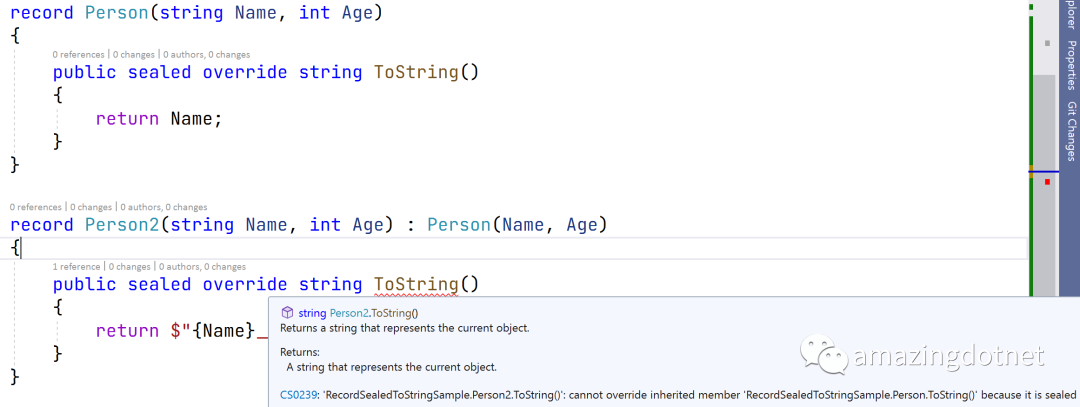C# 10 新特性 —— 补充篇
Intro
前面已经写了几篇文章介绍 C# 10 新特性的文章,还有一些小的更新
Constant interpolated strings
在之前的版本中,如果想要使用插值字符串来,则不能声明为一个常量
如果依赖于一个常量的插值字符串就只能声明为一个 static 的变量,比如说下面这个例子:
private const string Name = "Alice";
private static readonly string Hello = $"Hello {Name}";在 C# 10 中我们可以将 Hello 也声明为常量(const),如下:
public string const Name = "Alice";
public string const Hello = $"Hello {Name}";这种常量插值字符串参数只适用于字符串,如果是 int 就不行了,比如说,如果写一段下面这样的代码:
private const int Num = 10;
private const string HelloNum = $"Hello {Num}";这里插值字符串的参数是一个 int 类型,实际编译器会直接报错,报错信息如下:
// Error CS0133 The expression being assigned to 'ConstantInterpolatedStringSample.HelloNum' must be constant
上一篇文章中,我们有提到像 int/DateTime 等这种数据字符串插值是会依赖当前的一个 CultureInfo,所以作为插值字符串的时候不是一个编译时就确定的一个值,不能被认为是常量
这个特性的插值参数必须是字符串常量。
Extended property patterns
C# 10 针对模式匹配有一点小优化,针对嵌套的属性模式写法做了一些简化,如:
if (e is MethodCallExpression { Method: { Name: "MethodName" } })C# 10 新写法:
if (e is MethodCallExpression { Method.Name: "MethodName" })一个完整的简单小例子如下:
record TestModelA(TestModelB B, string Name);
record TestModelB(TestModelC C, string Name);
record TestModelC(string Name);var a = new TestModelA(new TestModelB(new TestModelC("C"), "B"), "A");
if (a is { B.C.Name.Length: > 0 })
{Console.WriteLine(a.B.C.Name);
}Record types can seal ToString
在 C# 10 中我们可以把 record 类型的 ToString() 方法标记为 sealed,这样继承于它的子类就不能再重写这个方法了,可以用来保护 ToString() 输出的格式,保证输出的格式是一致的,使用起也很简单,直接在 ToString 方法中声明 sealed 即可,示例如下:
record Person(string Name, int Age)
{public sealed override string ToString(){return Name;}
}这样如果继承于它的 record 想要重写 ToString 方法的时候就会报错

前面我们提到过 C# 10 中增加了 record struct,它可以使用这个特性吗?答案是不可以,这一特性仅针对于 record class,在 record struct 中使用会得到一个类似下面的错误

Assignment and declaration in same deconstruction
在之前的版本中,我们如果想要使用 tuple 返回值,必须要同时初始化,如下:
private static (int month, int day) GetDate()
{var today = DateTime.Today;return (today.Month, today.Day);
}(var month, var day) = GetDate();
Console.WriteLine($"Month: {month}, day: {day}");我们必须要同时声明 month/day,在 C# 10 中我们既可以使用已有变量又可以声明新的变量,可以结合在一起使用,如下:
(var month, var day) = GetDate();
Console.WriteLine($"Month: {month}, day: {day}");(month, var day2) = GetDate();
Console.WriteLine($"Month: {month}, day: {day2}");(month, day) = GetDate();
Console.WriteLine($"Month: {month}, day: {day}");Improved definite assignment
C# 10 中编译器会做更多的推断从而大大方便我们的使用,之前介绍的 Lamdba 的一些优化都是由编译器做的推断,针对于初始化赋值的 null 检查也有一些优化,下面是微软给出的一个示例,在之前的版本中会有警告,但是在 C# 10 之后就没有警告了
string representation = "N/A";
if ((c != null && c.GetDependentValue(out object obj)) == true)
{representation = obj.ToString(); // undesired error
}// Or, using ?.
if (c?.GetDependentValue(out object obj) == true)
{representation = obj.ToString(); // undesired error
}// Or, using ??
if (c?.GetDependentValue(out object obj) ?? false)
{representation = obj.ToString(); // undesired error
}Allow AsyncMethodBuilder attribute on methods
从 C# 10 开始我们可以在异步方法上设置 AsyncMethodBuild 来自定义要处理异步任务的方式,这有对于要实现性能更好的异步方法处理方式的用户会更加的方便
比如这样一个异步方法:
public async ValueTask<T> ExampleAsync() { ... }实际编译器会生成这样的代码:
[AsyncStateMachine(typeof(<ExampleAsync>d__29))]
[CompilerGenerated]
static ValueTask<int> ExampleAsync()
{<ExampleAsync>d__29 stateMachine;stateMachine.<>t__builder = AsyncValueTaskMethodBuilder<int>.Create();stateMachine.<>1__state = -1;stateMachine.<>t__builder.Start(ref stateMachine);return stateMachine.<>t__builder.Task;
}使用这种方式,我们可以控制异步方法的处理
[AsyncMethodBuilder(typeof(PoolingAsyncValueTaskMethodBuilder<>))] // new usage, referring to some custom builder type
static async ValueTask<int> ExampleAsync() { ... }这样实际生成的代码类似下面这样
[AsyncStateMachine(typeof(<ExampleAsync>d__29))]
[CompilerGenerated]
[AsyncMethodBuilder(typeof(PoolingAsyncValueTaskMethodBuilder<>))] // retained but not necessary anymore
static ValueTask<int> ExampleAsync()
{<ExampleAsync>d__29 stateMachine;stateMachine.<>t__builder = PoolingAsyncValueTaskMethodBuilder<int>.Create(); // <>t__builder now a different typestateMachine.<>1__state = -1;stateMachine.<>t__builder.Start(ref stateMachine);return stateMachine.<>t__builder.Task;
}更多细节可以参考:
https://docs.microsoft.com/en-us/dotnet/csharp/language-reference/proposals/csharp-10.0/async-method-builders
Generic Attribute
Generic Attribute 目前还不算是 C# 10 新特性中的一部分,但是已经可以使用了,需要声明 LangVersion 为 preview,否则会看到类似下面的一个错误

因为可以用了,而且想在我的项目里使用,所以想尝试一下,但是就目前来说,还不能满足我的需要,简单看一下好了
我们可以这样用
[ExcelConfiguration<TestModel>]
public class TestModel
{public int Id { get; set; }public string Title { get; set; } = string.Empty;
}[AttributeUsage(AttributeTargets.Class | AttributeTargets.Struct)]
public class ExcelConfigurationAttribute<T> : Attribute
{public string DefaultFileName { get; set; } = "unnamed-file.xlsx";public Func<T, bool> DataValiadator { get; set; } = _ => true;
}但是如果想在声明 Attribute 的地方指定泛型委托会报错,错误信息如下:
'DataValiadator' is not a valid named attribute argument because it is not a valid attribute parameter type

类似的还有一个 Generic Math 的功能也可以预览使用,但是对我来说感觉意义不是特别大,所以就不介绍了,感兴趣的可以参考:https://devblogs.microsoft.com/dotnet/preview-features-in-net-6-generic-math/
对于预览版特性,如果不是特别需要建议还是不要轻易在生产代码里用,以后被砍了就尴尬了
More
原来有很多原本计划在 C#10 的特性被推到了 C# 11中,比如 filed 关键词、required 成员针对集合的模式匹配等,但总体来说还是有很多不错的新特性了,还没用 C# 10 的小伙伴们可以用起来了~~
C# 10 新特性解析的系列文章到此就结束了,如果有错误的地方欢迎指出,万分感谢
C# 10 新特性的示例代码可以从 Github 上获取:https://github.com/WeihanLi/SamplesInPractice/tree/master/CSharp10Sample
更多特性介绍可以参考微软的文档,可以参考文末的参考链接
References
https://docs.microsoft.com/en-us/dotnet/csharp/whats-new/csharp-10
https://docs.microsoft.com/en-us/dotnet/csharp/language-reference/proposals/csharp-10.0/constant_interpolated_strings
https://docs.microsoft.com/en-us/dotnet/csharp/language-reference/proposals/csharp-10.0/extended-property-patterns
https://docs.microsoft.com/en-us/dotnet/csharp/language-reference/proposals/csharp-10.0/improved-definite-assignment
https://docs.microsoft.com/en-us/dotnet/csharp/language-reference/proposals/csharp-10.0/async-method-builders












)


)


 of Objective-C)
